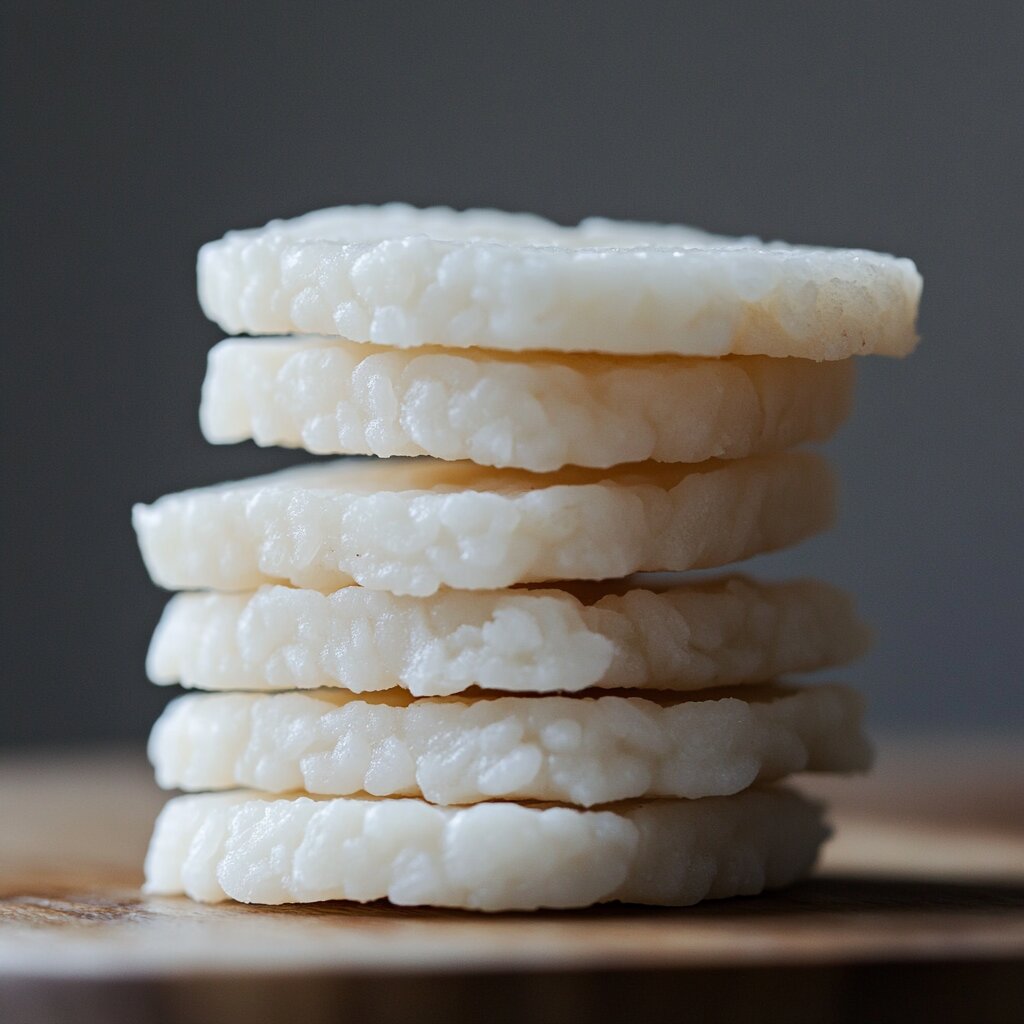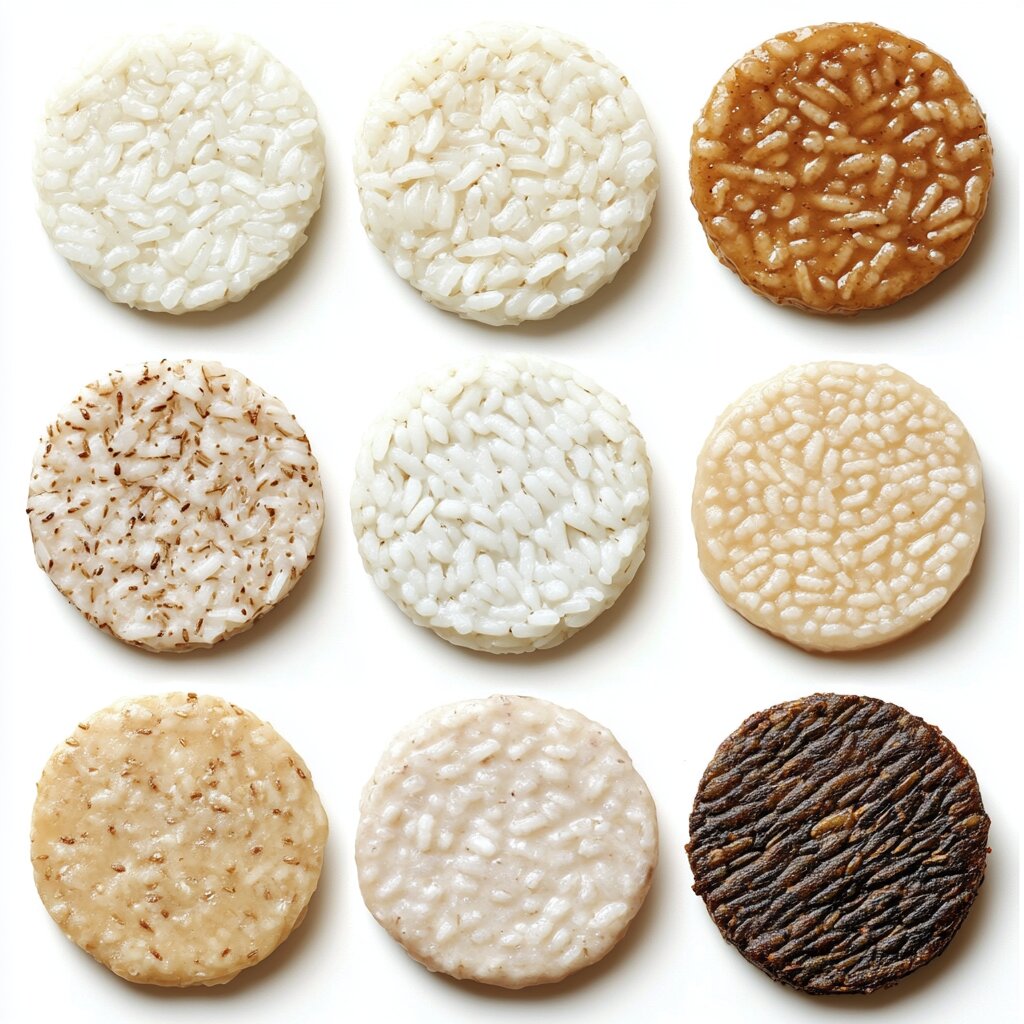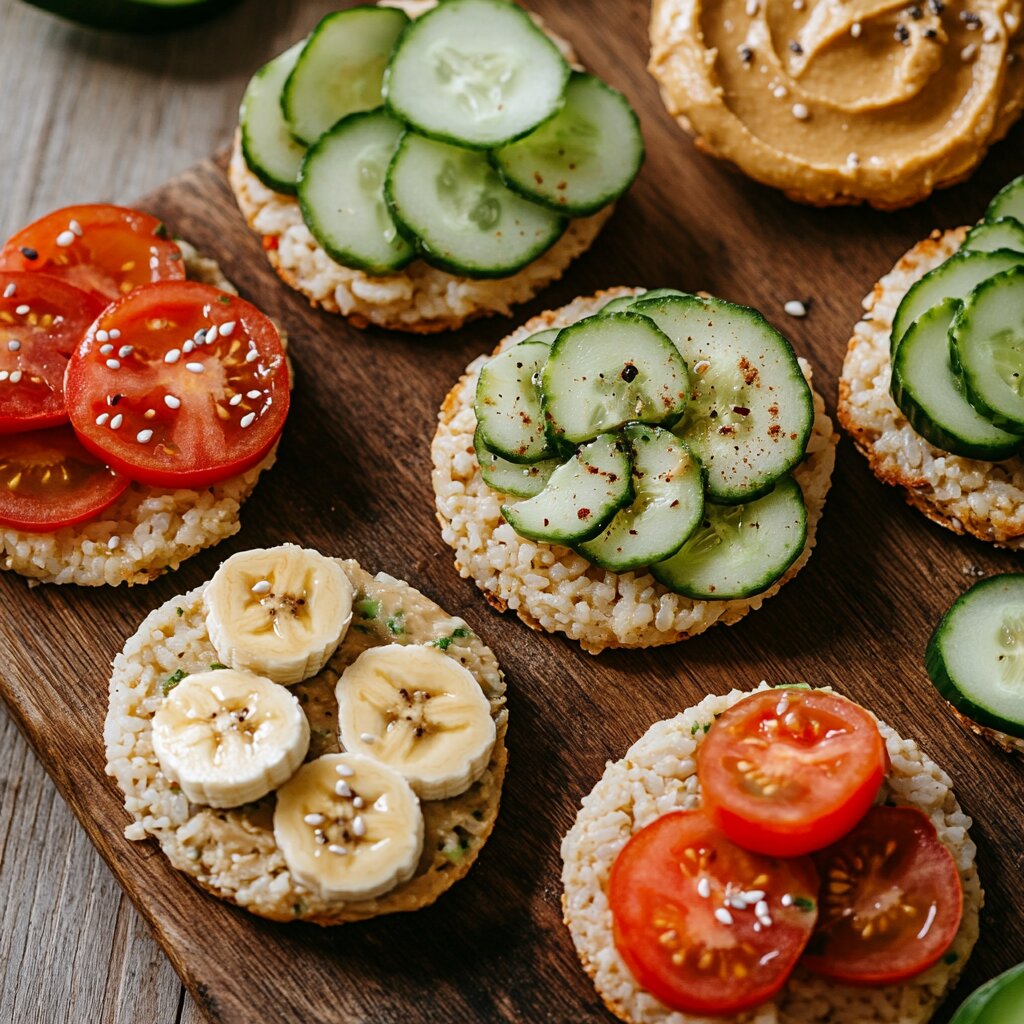
Rice cakes remain a popular snack for those who want a light, crunchy treat. However, if you’re wondering, ‘Are rice cakes high in carbs?,’ this guide will help you understand their nutritional content and how they fit into your dietary goalsRice cakes remain a popular snack for those who want a light, crunchy treat. However, if you’re following a low-carb diet, you might question whether they fit your nutritional goals. This guide dives deep into rice cakes’ nutritional content, their carbohydrate levels, and how they compare to other snacks. By the end, you’ll know if rice cakes suit your diet or if you should explore alternatives.
Table of Contents
What Are Rice Cakes?
Rice cakes consist of puffed rice grains that are compressed into circular or rectangular shapes. People enjoy these snacks for their versatility, low calorie count, and satisfying crunch. Many people eat rice cakes plain, but they also work well as a base for various toppings. Moreover, different varieties cater to a wide range of tastes and dietary preferences. Despite their appeal, understanding their nutritional value is essential for making informed dietary choices.
Origin and History of Rice Cakes
Rice cakes have a long history in East and Southeast Asian cultures. In countries like Japan, Korea, and China, people have made rice cakes from glutinous rice for centuries. For example, Japanese mochi often appears during festivals and celebrations. In the 20th century, Western countries developed the modern puffed rice cake as a health-conscious snack. Consequently, this version gained popularity as a low-calorie alternative to bread and crackers. Over time, manufacturers introduced more flavors and varieties to meet evolving consumer demands. As a result, rice cakes are now enjoyed globally.
Common Types of Rice Cakes
Rice cakes come in several forms, each offering different nutritional benefits. Therefore, choosing the right type helps you match them to your dietary goals.

Plain Rice Cakes
Manufacturers make plain rice cakes from white or brown rice, with few additional ingredients. These cakes are light, crispy, and contain minimal calories. Each serving typically has 7–8 grams of carbs. Because they lack flavor, many people use them as a base for toppings. Since plain rice cakes offer little fiber or protein, adding avocado, nut butter, or hummus can create a more balanced snack. Consequently, this pairing helps enhance both the taste and nutritional value.
Flavored Rice Cakes
Flavored rice cakes provide more taste than plain versions. Popular options include cheese, caramel, chocolate, and barbecue. However, these flavors often come with added sugars, salt, and artificial ingredients. For instance, a caramel-flavored rice cake may contain up to 12 grams of carbs, including 3–4 grams of sugar. If you monitor your sugar intake, reading labels carefully becomes crucial to avoid unwanted additives. Therefore, choosing flavors with minimal additives lets you enjoy variety without sacrificing health.
Brown Rice Cakes
Brown rice cakes use whole-grain brown rice, which keeps the nutrient-rich bran layer intact. As a result, they offer more fiber, vitamins, and minerals than white rice cakes. Typically, each brown rice cake contains about 8–9 grams of carbs and more fiber. This added fiber aids digestion and helps you feel fuller for longer. Many people prefer brown rice cakes for their nuttier flavor and added health benefits. For more on the benefits and recipes, Check out this guide on Rice Cakes Benefits and Recipes for Healthy Snacking for more insights into the nutritional benefits and creative ways to enjoy rice cakes. Additionally, pairing them with healthy toppings can further enhance their nutritional value.
Nutritional Breakdown of Rice Cakes
Understanding rice cakes’ nutritional content helps you decide if they fit your diet. Let’s break down their macronutrient and micronutrient profiles.
Macronutrient Composition (Carbs, Protein, Fat)
Many people ask, ‘Are rice cakes high in carbs?’ Given that each rice cake contains 7–12 grams of carbohydrates, this is an important consideration for low-carb diets.
Because rice cakes lack protein and fat, they may not keep you full for long. To make them more satisfying, pair them with protein- or fat-rich toppings. For example, spreading peanut butter on a rice cake or topping it with cottage cheese can improve satiety. Additionally, this combination helps slow digestion and stabilizes blood sugar levels.
Micronutrients in Rice Cakes (Vitamins and Minerals)
Plain rice cakes, especially those made from white rice, offer few vitamins and minerals. During processing, the refining process removes most of the bran and germ, which contain essential nutrients. However, brown rice cakes retain more nutrients and offer small amounts of:
- Magnesium
- Phosphorus
- Manganese
These minerals support bone health, energy production, and overall well-being. While brown rice cakes provide slightly more nutrients, they still lack the density found in whole foods. Therefore, including fruits, vegetables, and lean proteins alongside rice cakes helps maintain a balanced diet.
What You Need to Know About Carbs in Rice Cakes
Carb Amounts in Different Types of Rice Cakes
A single rice cake typically contains:
- Plain White Rice Cake: 7–8 grams of carbs
- Brown Rice Cake: 8–9 grams of carbs
- Flavored Rice Cake: 9–12 grams of carbs
The carb content varies depending on the type and any additional flavorings. Although plain and brown rice cakes have similar carb counts, the fiber in brown rice helps reduce blood sugar spikes. On the other hand, flavored varieties often contain added sugars, which increase the total carbs. Therefore, if you track your carb intake, pay attention to serving sizes and ingredient lists.
Comparison of Carbs in Different Types of Rice Cakes
Different types of rice cakes have slight variations in carb content:
- Plain White Rice Cakes: Simple and low in fiber, making them less nutritious.
- Brown Rice Cakes: Contain more fiber and nutrients, making them a healthier choice.
- Flavored Rice Cakes: Often have added sugars and artificial ingredients, increasing carb counts.
If you follow a low-carb diet, even these small amounts of carbs can add up quickly. Therefore, consider low-carb alternatives like cucumber slices, celery sticks, or cheese crisps. These options provide a satisfying crunch with fewer carbs and more nutrients.
Do Rice Cakes Fit Low-Carb Diet Plans?
Can They Fit into a Keto-Friendly Diet?
If you are following a ketogenic diet, rice cakes may not be the best snack option. The keto diet requires you to limit your daily carb intake to around 20–50 grams. Since a single rice cake contains 7–12 grams of carbs, eating just a few could quickly use up your carb allowance. Furthermore, rice cakes lack the healthy fats that are essential on a keto diet. As a result, consuming rice cakes can disrupt ketosis, which is the process where your body burns fat for energy instead of carbs.
For those on a strict keto diet, it’s better to choose snacks that are high in healthy fats and low in carbs. Options like avocado slices, cheese crisps, nuts, and seeds are more suitable because they provide the necessary fats to fuel your body while keeping carb intake low. Therefore, while rice cakes may be convenient, they do not align well with a keto lifestyle.
Alternatives to Rice Cakes for Low-Carb Diets
If you are looking for low-carb alternatives to rice cakes, there are several options that provide a similar crunchy texture without the high carb content. For instance:
- Cucumber Slices: These are low in carbs and offer a refreshing crunch. You can top them with cream cheese, avocado, or hummus for added flavor.
- Celery Sticks: With their natural crunch and low-carb content, celery sticks make a great base for toppings like peanut butter or tuna salad.
- Cheese Crisps: These baked cheese snacks are high in protein and fat, making them ideal for low-carb and keto diets.
- Lettuce Wraps: Using large lettuce leaves as a wrap provides a low-carb alternative to bread or rice cakes. Fill them with turkey, avocado, or egg salad for a satisfying snack.
In conclusion, these alternatives can help you maintain your low-carb goals while still enjoying a satisfying crunch.
How Do Rice Cakes Impact Blood Sugar Levels?
Glycemic Index of Rice Cakes
Rice cakes have a high glycemic index (GI), typically ranging from 70 to 90. The glycemic index measures how quickly a food raises blood sugar levels. Foods with a high GI cause a rapid spike in blood glucose, which can lead to energy crashes and increased hunger shortly afterward. Because rice cakes are made primarily from refined rice, they lack the fiber needed to slow down digestion and stabilize blood sugar levels.
Brown rice cakes, while slightly lower on the glycemic index, still have a significant impact on blood glucose. Therefore, if you are managing blood sugar levels, such as in the case of diabetes, consuming rice cakes may not be the best option. Pairing rice cakes with protein- or fat-rich toppings can help mitigate their glycemic impact by slowing down sugar absorption.
Rice Cakes and Insulin Response
Due to their high glycemic index, rice cakes can cause a spike in insulin levels. When you eat high-GI foods, your body releases more insulin to help process the glucose in your bloodstream. Over time, frequent spikes in insulin can contribute to insulin resistance, a risk factor for type 2 diabetes.
For individuals with diabetes or those at risk, it is important to choose snacks that promote stable blood sugar levels. Opt for snacks that are rich in fiber, protein, and healthy fats. If you do choose to eat rice cakes, pair them with foods like nut butter, cottage cheese, or avocado to balance their impact on blood sugar.
Health Benefits of Rice Cakes
Low-Calorie Snacking Option
One of the main reasons people enjoy rice cakes is because they are low in calories. If you’re curious about whether rice cakes are actually healthy, read more in our detailed guide Are Rice Cakes Actually Healthy? for an in-depth analysis. A plain rice cake typically contains only 35–60 calories, making it an attractive option for weight-conscious individuals. When compared to higher-calorie snacks like bread or crackers, rice cakes can help you manage your calorie intake more effectively. However, it’s essential to remember that rice cakes are not very filling on their own. Adding healthy toppings can increase satiety while keeping the overall calorie count low.
Gluten-Free Benefits
Rice cakes made from 100% rice are naturally gluten-free, making them a safe choice for those with celiac disease or gluten intolerance. Unlike many other snack options that contain wheat or gluten-based additives, plain rice cakes provide a simple and convenient gluten-free alternative. Additionally, they are widely available in most grocery stores, making them an easy go-to option for gluten-sensitive individuals.
Potential Downsides of Eating Rice Cakes
High Carbohydrate Content for Some Diets
Although rice cakes are low in calories, they are high in carbohydrates. Each cake contains 7–12 grams of carbs, which can add up quickly if you eat multiple servings. This high carb content may not align with low-carb or ketogenic diets. Therefore, if you are limiting your carb intake, it’s best to consume rice cakes in moderation or choose lower-carb alternatives.
Lack of Nutrient Density
Rice cakes offer minimal nutritional value. They contain very little protein, fat, vitamins, or minerals. While brown rice cakes provide slightly more nutrients due to their whole-grain content, they still fall short compared to nutrient-dense foods like fruits, vegetables, and whole grains. Therefore, relying on rice cakes as a primary snack can lead to nutrient deficiencies. To enhance their nutritional value, pair rice cakes with toppings that provide protein, healthy fats, and vitamins.
How to Incorporate Rice Cakes into a Balanced Diet
Healthy Topping Ideas for Rice Cakes

To make rice cakes a healthier and more satisfying snack, pair them with nutrient-rich toppings. Here are some ideas:
- Avocado and Tomato: Top a rice cake with mashed avocado, cherry tomatoes, and a sprinkle of sea salt.
- Nut Butter and Banana: Spread almond or peanut butter on a rice cake and add banana slices for a balanced snack.
- Hummus and Cucumber: Add a layer of hummus and top with cucumber slices for a refreshing option.
- Cottage Cheese and Berries: For a sweet and savory combo, spread cottage cheese and add fresh berries.
Meal and Snack Ideas with Rice Cakes
Rice cakes can be part of various meals and snacks throughout the day. For example:
- Breakfast: A rice cake topped with almond butter, banana slices, and a sprinkle of cinnamon.
- Lunch: Use rice cakes as a base for turkey slices, lettuce, and mustard.
- Snack: Pair a rice cake with cottage cheese and cherry tomatoes for an afternoon pick-me-up.
Incorporating these combinations ensures that your snacks are more balanced and satisfying.
How Rice Cakes Stack Up Against Other Snacks
Rice Cakes vs. Bread
When comparing rice cakes to bread, it’s important to consider their carbohydrate content and overall nutritional value. One plain rice cake typically contains 7–8 grams of carbs, while a single slice of white bread contains 15–20 grams of carbs. Therefore, rice cakes offer fewer carbs per serving compared to bread. However, bread often contains more fiber, protein, and nutrients, especially if you choose whole-grain varieties.
Additionally, bread tends to be more filling because of its higher fiber and protein content. In contrast, rice cakes are less satiating due to their low fiber and protein levels. If you are watching your carb intake but need something more filling, opt for whole-grain bread rather than rice cakes. Alternatively, pairing rice cakes with protein-rich toppings can help balance their lower satiety factor.
Rice Cakes vs. Crackers
Crackers are another common snack option, and they vary widely in terms of carb content and nutritional value. Four standard crackers generally contain 10–15 grams of carbs, which is similar to the carb content of one rice cake. However, whole-grain or seed-based crackers offer additional fiber and nutrients that rice cakes lack.
Moreover, crackers often contain added fats and oils, which can make them more calorie-dense than rice cakes. For example, while a rice cake might have 35–60 calories, a serving of crackers can have 100–150 calories. If you are looking for a light snack with fewer calories, rice cakes are a better choice. On the other hand, if you need a more nutrient-dense snack, whole-grain crackers with healthy toppings may be more satisfying.
FAQs About Rice Cakes and Carbs
Are Rice Cakes Good for Weight Loss?
Yes, rice cakes can be beneficial for weight loss due to their low-calorie content. One plain rice cake contains only 35–60 calories, making it a great option for a light snack. However, because rice cakes lack fiber and protein, they may not keep you full for long. Therefore, pairing them with healthy toppings like nut butter, avocado, or hummus can help increase satiety. Additionally, moderation is key. Eating too many rice cakes in one sitting can add up in terms of carbs, which may hinder your weight loss efforts.
Can Diabetics Eat Rice Cakes?
Diabetics should be cautious when eating rice cakes due to their high glycemic index (GI). Rice cakes have a GI ranging from 70 to 90, which means they can cause rapid spikes in blood sugar levels. To minimize this effect, pair rice cakes with protein or healthy fats, such as peanut butter or cottage cheese. These toppings help slow down the absorption of sugar into the bloodstream. Alternatively, choosing brown rice cakes over white rice cakes can offer slightly more fiber and nutrients, which may help with blood sugar control. Always consult with a healthcare professional before making significant changes to your diet.
What Are Some Low-Carb Alternatives to Rice Cakes?
If you are following a low-carb diet, several alternatives can provide the same crunchy texture with fewer carbs. For example:
- Cucumber Slices: These are low in carbs and offer a refreshing crunch. They work well with toppings like cream cheese, tuna, or guacamole.
- Celery Sticks: Naturally low in carbs, celery sticks are perfect for pairing with peanut butter or cheese.
- Cheese Crisps: These baked cheese snacks are high in protein and fat, making them ideal for low-carb diets.
- Bell Pepper Slices: Bell peppers are crunchy and naturally sweet, offering a low-carb base for dips and spreads.
These options allow you to enjoy a satisfying crunch while keeping your carb intake in check.
How Many Rice Cakes Can I Eat on a Low-Carb Diet?
If you are on a low-carb diet, you should limit your intake of rice cakes. One rice cake contains 7–12 grams of carbs, depending on the type and flavor. Therefore, eating more than 1–2 rice cakes can quickly add up and exceed your daily carb limit. Instead, opt for low-carb snacks like cheese, nuts, or vegetables to stay within your carb goals. If you still want to enjoy rice cakes occasionally, balance them with high-protein or high-fat toppings to slow digestion and minimize blood sugar spikes.
Are Rice Cakes Healthier Than Chips?
Rice cakes and chips serve different purposes, but rice cakes are often considered a healthier option. Plain rice cakes are low in fat and calories, with only 35–60 calories per cake. In contrast, a serving of chips can contain 150–200 calories and significant amounts of unhealthy fats and sodium. However, rice cakes lack nutrients and fiber, making them less filling than chips. If you choose rice cakes over chips, try to balance them with nutrient-dense toppings. On the other hand, baked chips or chips made from vegetables can provide more nutrients than plain rice cakes.
Do Brown Rice Cakes Have Fewer Carbs?
Brown rice cakes do not necessarily have fewer carbs than white rice cakes. In fact, a brown rice cake typically contains 8–9 grams of carbs, similar to a white rice cake. However, brown rice cakes offer additional fiber, vitamins, and minerals because they use whole-grain rice. The extra fiber in brown rice can help improve digestion and may lead to better blood sugar control. Therefore, while the carb content is similar, brown rice cakes provide slightly more nutritional benefits.
Conclusion: Should You Include Rice Cakes in Your Diet?
Ultimately, rice cakes can be a healthy addition to your diet, depending on your goals and nutritional needs. They are low in calories, gluten-free, and versatile as a snack option. However, they are high in carbs and lack significant nutrients like fiber, protein, and healthy fats. If you are on a low-carb or ketogenic diet, rice cakes may not be the best choice.
To make rice cakes more nutritious, pair them with healthy toppings such as nut butter, avocado, hummus, or cottage cheese. These additions provide essential nutrients, boost satiety, and help stabilize blood sugar levels. Additionally, consider brown rice cakes over white rice cakes for extra fiber and nutrients.
In summary, enjoy rice cakes in moderation and as part of a balanced diet. If they align with your dietary needs, they can be a satisfying and convenient snack option.
